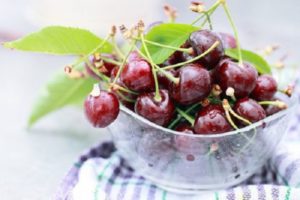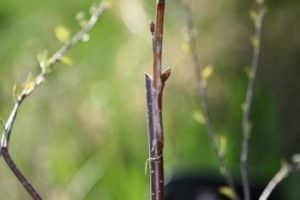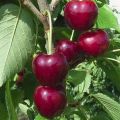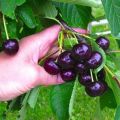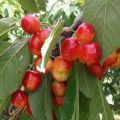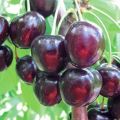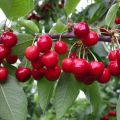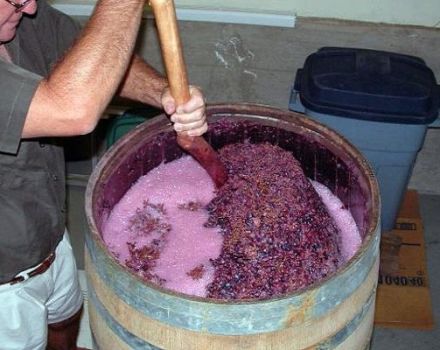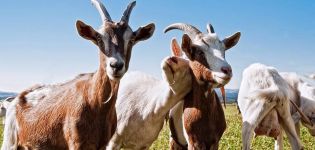Description and characteristics of the cherry variety Odrinka, planting and care
Cherry varieties Odrinka fell in love not only with summer residents, but also professional gardeners. It is distinguished by increased frost resistance, drought resistance and decent fruit qualities. The plant has been successfully cultivated in gardens for about a century. During this time, cherries have expanded their habitat, tested by time and have not lost their popularity.
How the variety is bred
Odrinka was originally grown as a southern tree. In the 19th century, the famous breeder I.V. Michurin thought about how to relocate cherries to more severe climatic conditions. However, his experiments were unsuccessful. But after some time the idea was embodied by the scientist F.K. Teterev, who lives in Leningrad. He took as a basis the varieties Zorka and Krasnaya dense, as a result of working with which the modern Odrinka was obtained. She got into the State Register in 2004. The variety is suitable for growing in the climate of the middle zone.
Photo and description
A photo and a short description of Odrinka give a brief idea not only about the tree itself, but also about the berries, their taste characteristics, and also allow us to formulate the main advantages and disadvantages of cherries.
general description
Odrinka is grown in all regions except the north. A tree of medium height with a compact, not thickened crown. Small flowers are collected in inflorescences of 3-4 pieces. The harvest is ripening late. It starts bearing fruit 5 years after planting the seedling. Sweet cherries require planting nearby pollinator varieties.
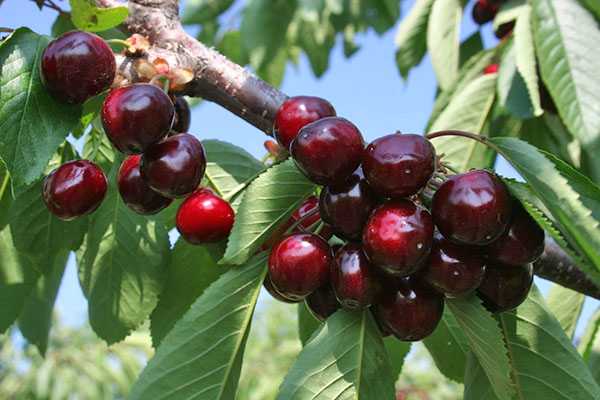
Advantages
Thanks to her merits, Odrinka won the love of gardeners and does not lose popularity. Its benefits include:
- resistance to pathogens;
- increased resistance to fungal diseases;
- stable fruiting;
- increased frost resistance;
- suitability for growing in the middle lane.
disadvantages
Cherry has no significant drawbacks. Gardeners distinguish only small sizes and weight of berries, because of which they are almost unsuitable for wholesale or retail trade.
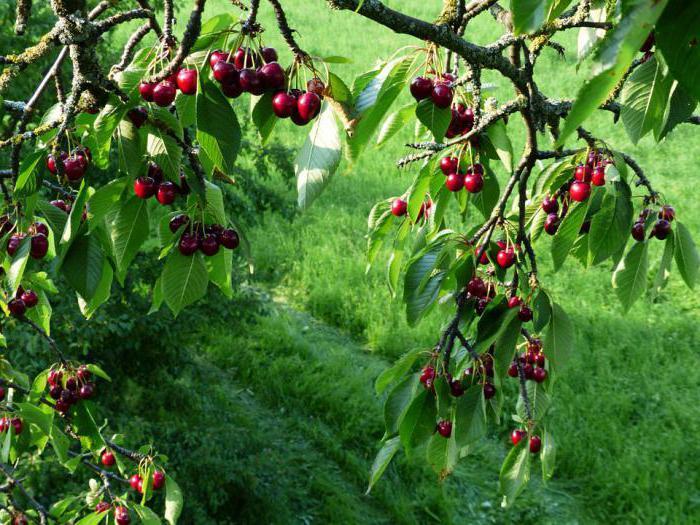
Bud
Odrinka's kidneys are small in size, resembling a cone in shape.They tolerate recurrent spring frosts and earlier autumn cooling.
Leaf and flower
The leaves of the cherry are of the generative type, ovoid, small in size, twigs deflected towards the side. The inflorescence contains a maximum of 4 small flowers. The corolla is saucer-shaped, the petals are white.
Fetus
The fruits have specific characteristics that distinguish them from other similar varieties.

Weight
Cherries of Odrinka reach a mass of 5 g, the maximum indicator is 7 g.
Height
The height of the fruit of the Odrinka variety is about 2.5 cm.
Width
Cherries grow up to 2.4 cm wide.
Thickness
Up to 6% of the total volume is allocated to the bone in the fruits of Odrinka, everything else falls on the pulp.
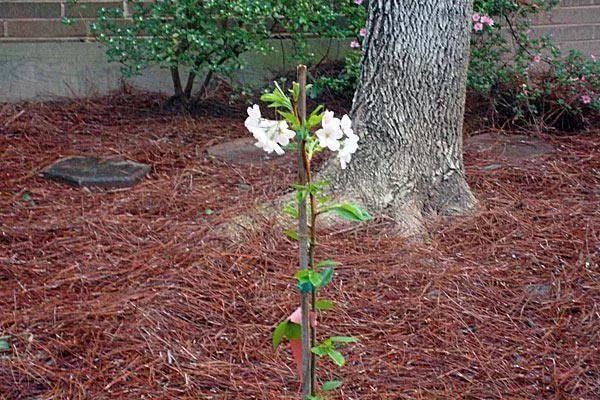
Color
When ripe, cherries acquire a beautiful purple color, while their juice is red.
Peduncle
Odrinka's peduncle is small, divided into 2 glands.
Bone
The seed in the fruit is small, takes up no more than 6% of the volume, and is easily separated from the juicy pulp.
general characteristics
The variety belongs to late ripening, flowering also comes late. Cherry is self-fertile, therefore it needs pollinating varieties nearby. The ovary is formed on the bouquet twigs.
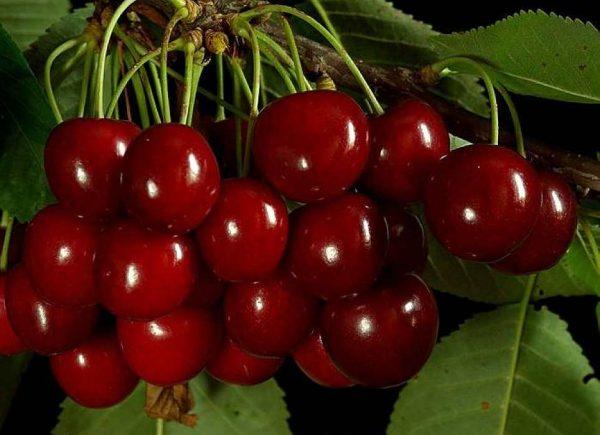
Taste qualities
Tasters rated Odrinka's taste at 4.7 points.
Content of nutrients
The fruits of Odrinka contain:
- dry matter - 17.5%;
- sugars - 11.2%;
- acids - 0.43%;
- ascorbic acid - 15 mg / 100 g.
Also in the fruits there is a supply of vitamins A, B1, B2, B6, B3, B9, C, E, P. The composition of cherries includes minerals:
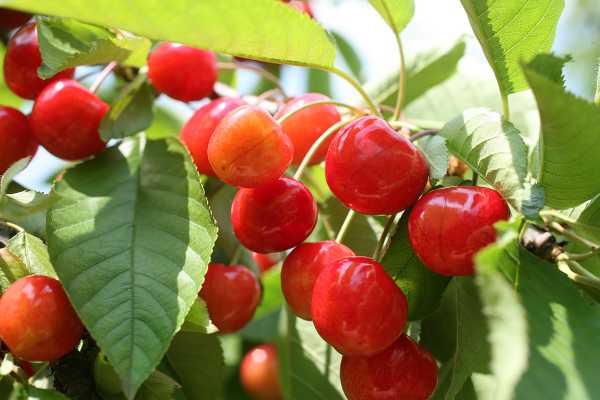
- potassium;
- calcium;
- phosphorus;
- magnesium;
- sodium;
- chlorine;
- sulfur;
- zinc;
- copper.
Tree height and growth rate
Odrinka's tree growth rate is average. Its maximum height reaches 3-4 m. The crown is not too thick, pyramidal.
Flowering and ripening period
Odrinka belongs to the late varieties of sweet cherry, its flowering also occurs with a delay, when other varieties are already beginning to form ovaries. The buds are collected in several pieces in inflorescences, the petals are white.

Yield
On average, up to 77 centners / ha of ripe fruits are removed from an adult Odrinka tree. Record yields were 221 c / ha, subject to the rules of agricultural technology.
Transportability
The dense pulp and strong skin make it easy to transport the harvested cherry crop over long distances and even store it for some time.
Drought tolerance
Odrinka has good drought resistance, its roots go deep into the ground and do not experience a moisture deficit. Watering the tree is carried out according to the standard scheme for this culture. Stagnant water is unacceptable.
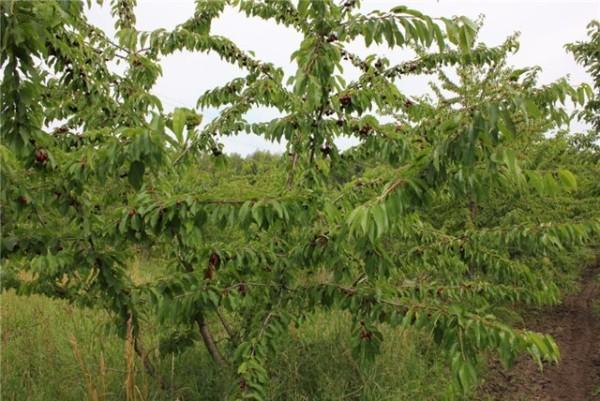
Frost resistance
A distinctive feature of this cherry variety is its high cold resistance. Frostbite almost does not appear on the trunk. The tree can freeze when the temperature drops below -29 ° C. In this case, up to 15% of flower buds are lost. But spring return frosts do much more harm, reducing yields by up to 30%.
Disease resistance
The risk of Odrinka being affected by diseases is minimal. She has increased resistance to such ailments:
- clotterosporium disease;
- coccomycosis;
- moniliosis.
In conditions of high humidity, the likelihood of developing fungal infections increases, and timely preventive treatments for Odrinka cherries are required.

Fruit application
The sweet cherry harvest is suitable for all types of processing, both for personal purposes and on an industrial scale. Due to their small size, the fruits are rarely sold as a whole, although they have an excellent taste.
Basic soil requirements
Loose loamy or sandy loam soil is ideal for growing Odrinka. Sandy soil, peat bog or wetland are not suitable for cherry cultivation. If the land is depleted, it is recommended to apply fertilizer in advance.

Landing features
Planting Odrinka has its own characteristics, on which the health of the tree itself depends, as well as the quality and quantity of the future harvest.
Sapling selection
It is preferable to purchase cherry seedlings in proven places, nurseries. For planting on the site, preference is given to trees with a height of 0.8-1.2 m. Young cherry trees should not have mechanical damage, broken branches, signs of diseases, blackened places, mold.
Root system
The roots of the Odrinka seedling should be well developed, not overdried. The presence of mechanical damage, mold is not allowed.
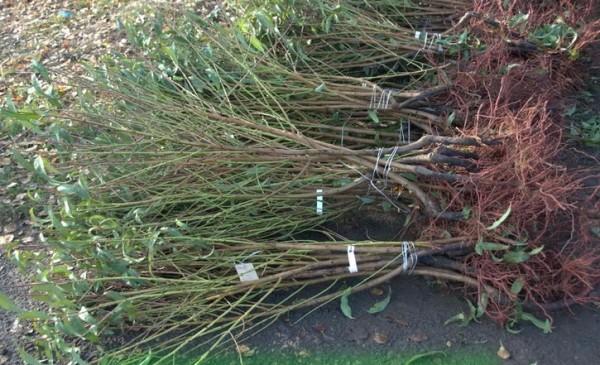
Trunk
For planting in the garden, choose a cherry seedling with a main conductor thickness of about 15 mm. Its bark should not have deformations, spots and scratches. Before buying, it is advisable to rub the barrel at the bottom of it with a damp cloth. If darkening becomes noticeable, then it is better to refuse to purchase such a plant.
Age
Cherries take root best of all, the age of which at the time of planting is 1-2 years.
Vaccination
The final characteristics of cherries largely depend on which rootstock is grafted on. It is necessary to pay attention not only to the description of the fruit, but also to the height of the tree, crown spreading, frost resistance and care features.
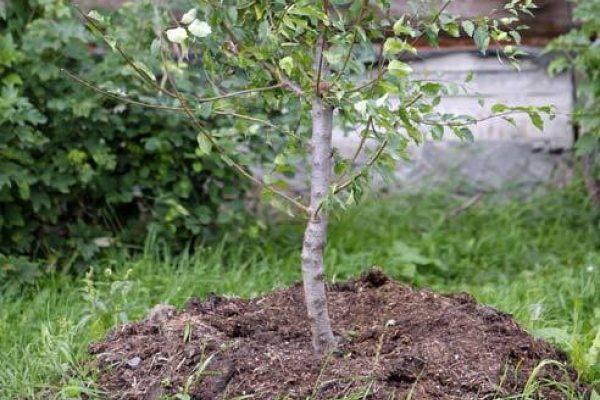
Planting timing
Sweet cherries are planted both in spring and autumn. The tree should have time to take root before the onset of stable cold weather, therefore planting is completed in early October. In the spring, it is preferable to manage before budding begins, that is, until mid or late April.
Site selection
Cherries are planted in a well-lit area protected from drafts. Odrinka should not compete with neighbors for nutrients and moisture, therefore it is advisable to remove it from apple trees, plums, pears and other fruit plantations.
It is preferable to land on the western or southern side of the site. The groundwater level should not come more than 2 m to the soil surface.
Pit preparation
It is preferable to dig a planting hole for cherries a couple of months before the planned planting. For spring planting, the groove is prepared in the fall. During this time, the soil must shrink. If necessary, fertilizers for young cherries are immediately embedded there, so that during the winter they have time to decompose and overheat.
The size of the hole is 70 x 70 cm, and its depth is about 0.8 m. Before planting Odrinka, a small mound of fertile soil mixture is formed at the bottom, on which a young plant is placed, the root system is carefully straightened and covered with earth. After that, the cherries are plentifully watered and the peri-stem circle is mulched.

Landing scheme
The distance between Odrinka and neighboring fruit trees or shrubs should be at least 3.5-4 m.
Pollinators
Pollinators must be planted near this cherry variety in order to get a stable and full harvest of useful berries. The best ones are those that have similar flowering times.
Jealous
The tree is small, the shape of the crown is pyramidal. Refers to self-fertile varieties of sweet cherries with high yield rates. The fruits are small in size, but very sweet, aromatic and tasty. Ravna is highly frost-resistant and, even during the flowering period, is able to withstand temperatures as low as -6 ° C. The harvested crop retains its qualities for a long time, it is suitable for transportation over long distances.
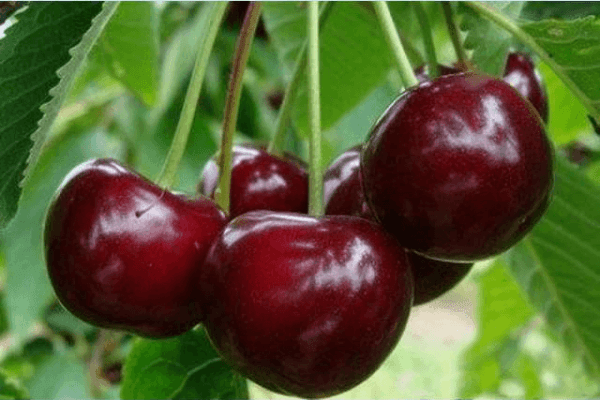
Gift to Stepanov
Medium-sized tree with a pyramidal crown. Differs in resistance to adverse weather conditions. The fruits of the sweet cherry are medium-sized, heart-shaped, and dark red when ripe. The tasters rated the palatability at 4.9 points out of a possible 5.
The crop is suitable for transportation and short storage, used for all types of processing. The cherry itself is characterized by increased drought resistance and frost resistance.
Rechitsa
This variety belongs to the bigarro group. Differs in high cold resistance and the ability to grow in a harsh climate. The cherry fruits are small, dark red in color and very sweet in taste. It has an increased resistance to common diseases.

Tyutchevka
A medium-sized tree has a very high cold resistance and immunity to diseases. Produces a bountiful harvest of medium-sized bright red cherries. The harvested crop is suitable for freezing, processing, as well as transportation over long distances. The variety is considered to be partially self-pollinated.
Care secrets
A bountiful harvest with the desired marketable and taste characteristics can be obtained only if the Odrinka cherries are properly cared for.
Watering
Sweet cherries require regular watering during flowering and ovary formation. But in the summer period, they try to reduce the amount of irrigation so that the ripening crop does not crack and retain its qualities longer.
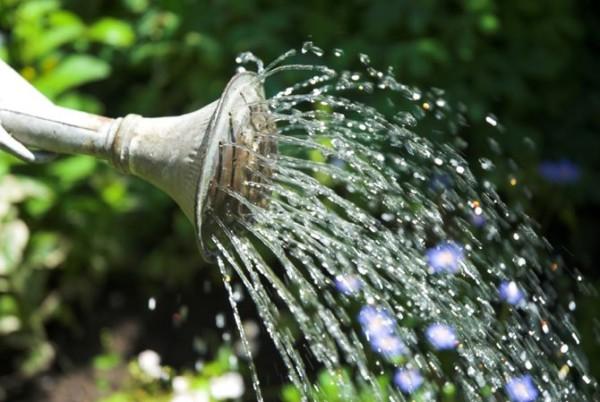
Top dressing
You should start feeding the plant in the third year of life. In the spring, fertilizers with a high nitrogen content are applied, and after the end of the cherry blossom period, superphosphate and potassium salt are added. Healthy farming people can benefit from organic fertilizers that have similar nutrients.
Slurry
The slurry contains a lot of potassium and nitrogen, but there is very little phosphorus. Fertilizer consists mainly of animal urine, and can also be formed from the decomposition of manure. It should be introduced directly into the near-stem circle of the cherry, while it is not necessary to dilute it with water.
It is recommended to add a little superphosphate to prevent the loss of free-flowing nitrogen.
Complex fertilizer
For feeding cherries, complex fertilizers are actively used, for example, nitrophoska or azofoska. It is preferable to bring them into the peri-stem circle in the fall, so that by the spring the nitrogen has time to decompose and does not harm the roots. You can also prepare nutritional mixtures for feeding yourself using several useful ingredients. In the autumn period, they try to apply less nitrogen, so as not to provoke premature growth of shoots.
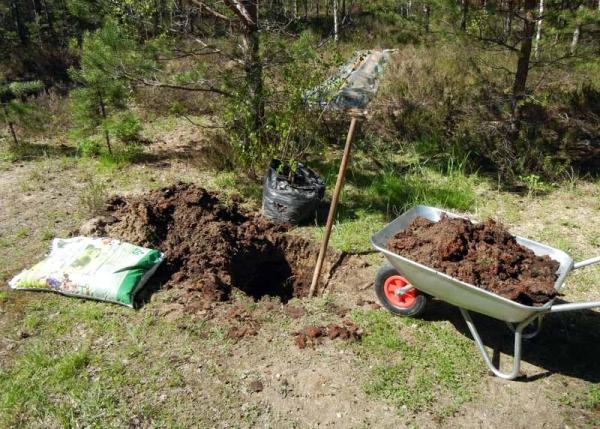
Ash
Wood ash contains such essential components of cherries as calcium, potassium, sodium and magnesium, as well as other substances that contribute to the normal growth and development of the tree. In addition, such feeding helps to fight pests and pathogens. It is necessary to bring ash into the periosteal circle. It is advisable to do this in the spring, but some gardeners also practice autumn feeding.
Urea
Urea belongs to organic fertilizers and contains up to 46% nitrogen. To feed cherries, 20-30 g of the substance is dissolved in 10 liters of water and poured into the periosteal circle. Work is performed a week after the end of the flowering period.

Pruning
Proper tree pruning not only increases yields, but also reduces the risk of diseases on cherries. They try to form a sparse-tiered type of crown. In each tier, up to 4 strong shoots are left, located at an obtuse angle to the main conductor. The distance between the tiers is 50 cm. All shoots with signs of disease, mechanical damage, as well as broken, dried or frostbitten must be removed.
Preparing for winter
In order for the Odrinka cherry to endure the harsh winter easier, it must be properly prepared.If the autumn turned out to be dry, then the soil in the near-trunk circle is watered abundantly so that it freezes more slowly. Such measures help protect the root system from freezing. It is advisable to mulch the soil around the trunk with peat or humus, laying a layer 15 cm thick. For a young plant, a frame is built and agrofibre or burlap is thrown over it. In winter, the trunk of a sweet cherry often becomes a delicacy for hares and small rodents.
For the purpose of protection, it is wrapped in a metal mesh or roofing material.
Diseases and pests
Cherry Odrinka is distinguished by its high resistance to diseases and the negative effects of pests, however, under adverse conditions, the risk of damage by them increases, and the plant requires additional protection.
Clasterosporium disease
Clasterosporia is a dangerous fungal disease that can affect all stone fruit plants. Cherry is no exception. Almost all above-ground parts of the tree are affected. A sign of infection is the appearance of orange or red spots on the shoots with black or brown edging. After some time, the spots increase in size, and then completely crack. A thick resinous substance begins to stand out from the wounds. Sometimes the disease even affects fruits and leaves.
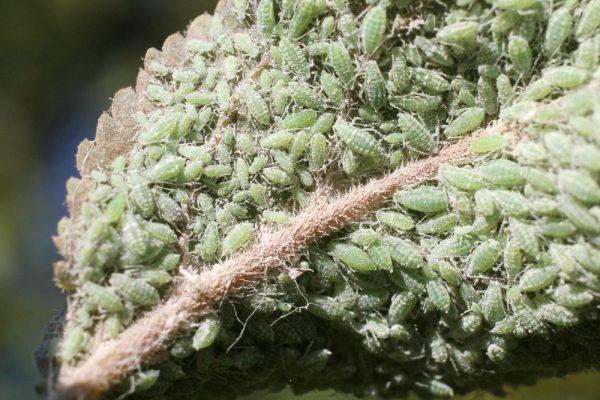
To combat fungal diseases, Bordeaux mixture is used, which is considered perhaps the most effective and time-tested remedy. A preventive measure is also the treatment of trees with iron vitriol, the preparation "Kaptan", "Horus", "Tsineb".
Moniliosis
Such a fungal disease not only reduces yield indicators, but can also lead to the death of cherries. Moniliosis affects parts such as:
- inflorescences;
- fruit;
- ovary;
- branches.
Cherry flowers and leaves look like dehydrated in appearance, and eventually fall off altogether. For prevention purposes, Odrinka is treated with copper-containing preparations, for example, "Mikosan-V" or "Horus". The causative agent of the disease does not tolerate low winter temperatures. Whitewashing with the addition of copper sulfate also has a detrimental effect on it.
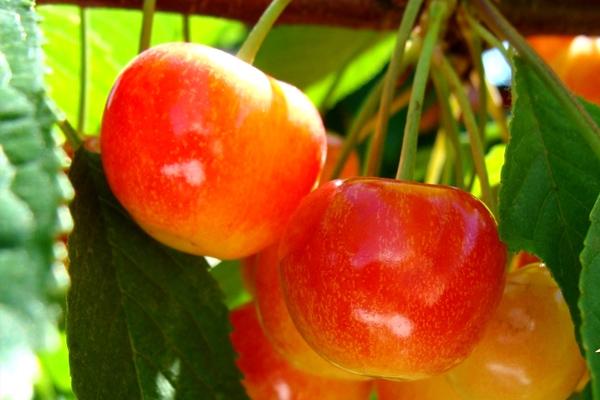
Black cherry aphid
Black cherry aphid attacks trees from spring to autumn and causes significant damage to the crop. It accumulates mainly on the underside of the cherry leaf plate. As a result of exposure to the pest, the leaves curl and fall off. A weakened tree can hardly endure the winter, and the risk of contracting serious diseases increases significantly.
To combat black aphids on Odrinka, drugs such as "Iskra", "Fitoverm" or "Commander" are used. For prevention purposes, marigolds, horseradish, tobacco and other plants with a strong aroma are planted nearby.
Leaf rollers
The leafworm is one of the most dangerous pests, capable of significantly reducing the yield of sweet cherries in a short period of time. The greatest danger is posed by the larvae that feed on the plant sap.
A sign of defeat is that the leaves are wrapped in a tube. When deployed, a cobweb can be found in the middle.
They fight the leaf roll by treating them with Lepidocid, Dendrobacillin, Atom, Karbofos, Accord, Fastak. From folk remedies are effective wormwood decoction, tobacco infusion, tomato leaf decoction, potato leaf infusion.
Cherry pipe runner
The gluttonous bug is able to destroy up to 50% of the Odrinka cherry crop. The pipe-runner spends the winter in the soil, therefore it is especially important to dig up the near-stem soil before the cold weather begins. In case of severe damage, they resort to the use of insecticides. Not only adults are dangerous, but also insect larvae, which eat away stamens and tiny buds, and also eat only the formed ovary.
Spring processing
Spring processing of Odrinka is carried out in order to prevent diseases and the spread of pests.Work begins as soon as the air warms up a little and the snow begins to melt. Sweet cherries are sprayed with urea solution or a special preparation "Nitrafen" is used. Do not allow it to get on the buds of the plant. In order to prevent pests, insecticidal agents "Confidor" and "Actellik" are used. The cherry trunk must be cleaned and then whitewashed.

Harvesting and storage
Harvesting of Odrinka cherries falls on June or early July. The timing may vary depending on the region of cultivation. The harvested fruits are difficult to keep fresh for a long time, therefore they are used mainly for processing. If you put them in a container and refrigerate, then you will be able to save the cherries for about 3-5 days.
Reviews
Gardeners had time to experience the advantages and disadvantages of Odrinka from personal experience. Many of them willingly share their impressions. Anna Dmitrievna, amateur gardener: “I have dreamed of cherries in my garden for a long time. Studying the characteristics of the varieties, I opted for Odrinka and Revna. The first harvest was waiting for several years, but Odrinka exceeded all my expectations. The beautiful and sweet fruits were enjoyed by the whole family. The variety is late, therefore, to protect against pests, I regularly carry out preventive spraying. "
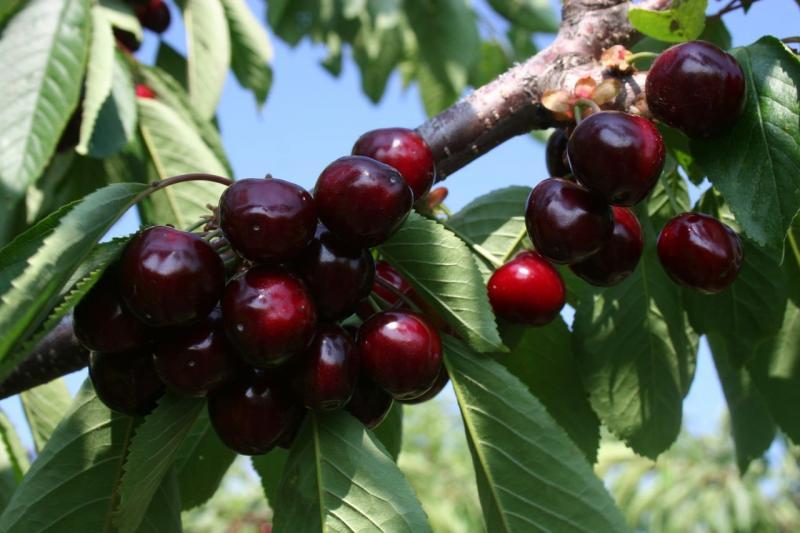
Maxim Ivanovich, a novice gardener: “I planted Odrinka in my garden as a pollinator for another well-known cherry variety. She began to bear fruit only in the 4th year after planting. The quality of the fruit was very surprising: beautiful, juicy, sweet and dense. All the efforts made to take care of the tree were fully justified. "
Marina Sergeevna, summer resident: “I planted 2 late varieties of cherries on my site, one of which is Odrinka. The description of the variety promised good frost resistance, which is very important for my climate. It must be admitted that sweet cherries are fully consistent with their declared characteristics. True, the fruits turned out to be small, but their taste pleased and compensated for this small drawback. "
